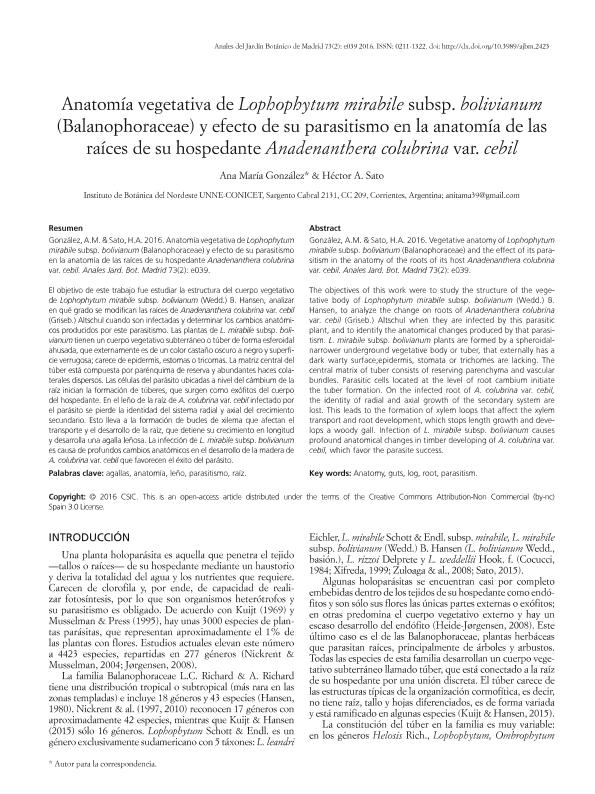Artículo
The objectives of this work were to study the structure of the vegetative body of Lophophytummirabile subsp. bolivianum; analyze the change on roots of Anadenanthera colubrina when they areinfected by this parasitic plant, and identify the anatomical changes produced by that parasitism.Lophophytum mirabile plants are formed by a spheroidal- narrower underground vegetative body ortuber, externally has a dark warty surface, lacks epidermis, stomata or trichomes. The central matrixof tuber consists of reserving parenchyma and vascular bundles. Parasitic cells located at the level ofroot cambium initiates the tubers formation, externally visible as exophyte . On the infected root ofA. colubrina, the identity of radial and axial growth of the secondary system it is lost. This leads to theformation of xylem loops that affecting the xylem transport and root development, which stopsgrowing in length and develops a woody gall. Infection of L. mirabile causes profound anatomicalchanges in developing timber of A. colubrina, which favor the successful of the parasite. El objetivo de este trabajo fue estudiar la estructura del cuerpo vegetativo de Lophophytum mirabile subsp. bolivianum (Wedd.) B. Hansen, analizar en qué grado se modifican las raíces de Anadenanthera colubrina var. cebil (Griseb.) Altschul cuando son infectadas y determinar los cambios anatómicos producidos por este parasitismo. Las plantas de L. mirabile subsp. bolivianum tienen un cuerpo vegetativo subterráneo o túber de forma esferoidal ahusada, que externamente es de un color castaño oscuro a negro y superficie verrugosa; carece de epidermis, estomas o tricomas. La matriz central del túber está compuesta por parénquima de reserva y abundantes haces colaterales dispersos. Las células del parásito ubicadas a nivel del cámbium de la raíz inician la formación de túberes, que surgen como exófitos del cuerpo del hospedante. En el leño de la raíz de A. colubrina var. cebil infectado por el parásito se pierde la identidad del sistema radial y axial del crecimiento secundario. Esto lleva a la formación de bucles de xilema que afectan el transporte y el desarrollo de la raíz, que detiene su crecimiento en longitud y desarrolla una agalla leñosa. La infección de L. mirabile subsp. bolivianum es causa de profundos cambios anatómicos en el desarrollo de la madera de A. colubrina var. cebil que favorecen el éxito del parásito.
Anatomía vegetativa de Lophophytum mirabile subsp. bolivianum (Balanophoraceae) y efecto de su parasitismo en la anatomía de las raíces de su hospedante Anadenanthera colubrina var. cebil
Título:
Vegetative anatomy of Lophophytum mirabile subsp. bolivianum (Balanophoraceae) and the effect of its parasitism in the anatomy of the roots of its host Anadenanthera colubrina var. cebil
Fecha de publicación:
06/2016
Editorial:
Consejo Superior de Investigaciones Científicas
Revista:
Anales del Jardín Botánico de Madrid
ISSN:
0211-1322
e-ISSN:
1988-3196
Idioma:
Español
Tipo de recurso:
Artículo publicado
Clasificación temática:
Resumen
Palabras clave:
Anatomy
,
Root
,
Log
,
Parasitism
Archivos asociados
Licencia
Identificadores
Colecciones
Articulos(IBONE)
Articulos de INST.DE BOTANICA DEL NORDESTE (I)
Articulos de INST.DE BOTANICA DEL NORDESTE (I)
Articulos(SEDE CENTRAL)
Articulos de SEDE CENTRAL
Articulos de SEDE CENTRAL
Citación
González, Ana María; Sato, Hector Arnaldo; Anatomía vegetativa de Lophophytum mirabile subsp. bolivianum (Balanophoraceae) y efecto de su parasitismo en la anatomía de las raíces de su hospedante Anadenanthera colubrina var. cebil; Consejo Superior de Investigaciones Científicas; Anales del Jardín Botánico de Madrid; 73; 2; 6-2016; 1-10; e039
Compartir
Altmétricas




